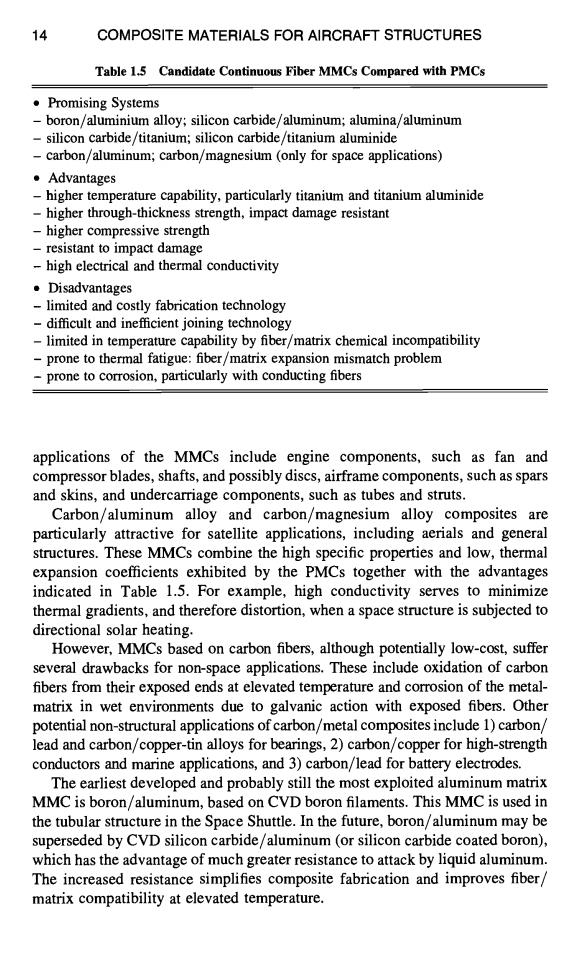正在加载图片...

14 COMPOSITE MATERIALS FOR AIRCRAFT STRUCTURES Table 1.5 Candidate Continuous Fiber MMCs Compared with PMCs ·Promising Systems boron/aluminium alloy;silicon carbide/aluminum;alumina/aluminum -silicon carbide/titanium;silicon carbide/titanium aluminide -carbon/aluminum;carbon/magnesium (only for space applications) ·Advantages -higher temperature capability,particularly titanium and titanium aluminide -higher through-thickness strength,impact damage resistant -higher compressive strength -resistant to impact damage -high electrical and thermal conductivity Disadvantages -limited and costly fabrication technology difficult and inefficient joining technology -limited in temperature capability by fiber/matrix chemical incompatibility -prone to thermal fatigue:fiber/matrix expansion mismatch problem -prone to corrosion,particularly with conducting fibers applications of the MMCs include engine components,such as fan and compressor blades,shafts,and possibly discs,airframe components,such as spars and skins,and undercarriage components,such as tubes and struts. Carbon/aluminum alloy and carbon/magnesium alloy composites are particularly attractive for satellite applications,including aerials and general structures.These MMCs combine the high specific properties and low,thermal expansion coefficients exhibited by the PMCs together with the advantages indicated in Table 1.5.For example,high conductivity serves to minimize thermal gradients,and therefore distortion,when a space structure is subjected to directional solar heating. However,MMCs based on carbon fibers,although potentially low-cost,suffer several drawbacks for non-space applications.These include oxidation of carbon fibers from their exposed ends at elevated temperature and corrosion of the metal- matrix in wet environments due to galvanic action with exposed fibers.Other potential non-structural applications of carbon/metal composites include 1)carbon/ lead and carbon/copper-tin alloys for bearings,2)carbon/copper for high-strength conductors and marine applications,and 3)carbon/lead for battery electrodes. The earliest developed and probably still the most exploited aluminum matrix MMC is boron/aluminum,based on CVD boron filaments.This MMC is used in the tubular structure in the Space Shuttle.In the future,boron/aluminum may be superseded by CVD silicon carbide/aluminum (or silicon carbide coated boron), which has the advantage of much greater resistance to attack by liquid aluminum. The increased resistance simplifies composite fabrication and improves fiber/ matrix compatibility at elevated temperature.14 COMPOSITE MATERIALS FOR AIRCRAFT STRUCTURES Table 1.5 Candidate Continuous Fiber MMCs Compared with PMCs • Promising Systems - boron/aluminium alloy; silicon carbide/aluminum; alumina/aluminum - silicon carbide/titanium; silicon carbide/titanium aluminide - carbon/aluminum; carbon/magnesium (only for space applications) • Advantages - higher temperature capability, particularly titanium and titanium aluminide - higher through-thickness strength, impact damage resistant - higher compressive strength - resistant to impact damage - high electrical and thermal conductivity • Disadvantages - limited and costly fabrication technology - difficult and inefficient joining technology - limited in temperature capability by fiber/matrix chemical incompatibility - prone to thermal fatigue: fiber/matrix expansion mismatch problem - prone to corrosion, particularly with conducting fibers applications of the MMCs include engine components, such as fan and compressor blades, shafts, and possibly discs, airframe components, such as spars and skins, and undercarriage components, such as tubes and struts. Carbon/aluminum alloy and carbon/magnesium alloy composites are particularly attractive for satellite applications, including aerials and general structures. These MMCs combine the high specific properties and low, thermal expansion coefficients exhibited by the PMCs together with the advantages indicated in Table 1.5. For example, high conductivity serves to minimize thermal gradients, and therefore distortion, when a space structure is subjected to directional solar heating. However, MMCs based on carbon fibers, although potentially low-cost, suffer several drawbacks for non-space applications. These include oxidation of carbon fibers from their exposed ends at elevated temperature and corrosion of the metalmatrix in wet environments due to galvanic action with exposed fibers. Other potential non-structural applications of carbon/metal composites include 1) carbon/ lead and carbon/copper-tin alloys for bearings, 2) carbon/copper for high-strength conductors and marine applications, and 3) carbon/lead for battery electrodes. The earliest developed and probably still the most exploited aluminum matrix MMC is boron/aluminum, based on CVD boron filaments. This MMC is used in the tubular structure in the Space Shuttle. In the future, boron/aluminum may be superseded by CVD silicon carbide/aluminum (or silicon carbide coated boron), which has the advantage of much greater resistance to attack by liquid aluminum. The increased resistance simplifies composite fabrication and improves fiber/ matrix compatibility at elevated temperature